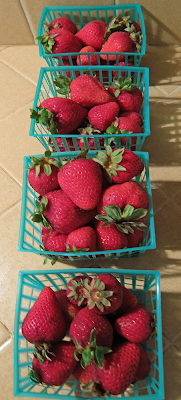 |
| From Ripest to Least Ripe |
Method by Robin and Live Earth Farm
Recently my husband Bruce did a Google search on “how to
slice a watermelon.” One of the top suggestions Google offered was “how to
store strawberries.” Seems like a lot of people are asking that question at
this time of year. And it’s a sad fact that the most deliciously ripe
strawberries can go moldy in a matter of hours if stored wrong. One bad
strawberry might not spoil the whole basket, but it certainly discourages one
from finding out by tasting.
The main cause of mold on strawberries is too much moisture
and too little air circulation. Hot temperatures, especially in humid climates,
are another factor. Keeping strawberries as dry as possible until just before
you prepare them to eat is the goal for successful storage.
Recently people been asking me about dousing their
strawberries with vinegar before storing, a suggestion they’ve seen on the
internet. I advise against this. Although the acid in vinegar might discourage
mold growth, the wetting of the berry does more harm than good in this regard,
IMHO. Vinegar can also draw moisture from the berries, leaving them flabby and
soggy. I believe this idea was originally recommended by Cook’s Illustrated for blueberries.
Here are my suggestions for storing strawberries. Some of
these ideas come from Live Earth Farm,
our CSA, and others we’ve developed ourselves.
Please post a comment if you have other suggestions!
1. Keep your strawberries dry and in the baskets that they
came in. Don’t wash them before storing. Wash them just before eating or
preparing for cooking.
2. If you can’t eat all the berries the day that you get them, store
them in the refrigerator. Keep them in their baskets, protected by a loosely
wrapped plastic bag. A green breathable bag, found at local natural food
stores, is ideal.
3. To absorb moisture, put a folded (in quarters) paper
towel on top of the basket of berries before putting strawberries into the
storage bag. If you store the berries for more than two days, check the towel.
If it’s very damp, exchange it with a dry towel. You can dry out the paper
towels between uses and reuse them on other strawberry baskets.
4. If you have several baskets of berries or a flat, sort
the berries by ripeness. Put into strawberry baskets, grouping berries of equal
ripeness together. Put each basket into a bag with a paper towel as above. Then
store in your refrigerator so that ripest berries are towards the front and
less ripe berries in back. This facilitates eating the ripest strawberries
first.
Bonus tip: Unlike other fruits, strawberries do not continue to ripen once they're picked. What you see in the store or at the fruit stand is what you get. Look for berries that are completely ripe, not yellowish or green at the stem end. Ideally, they will have a noticeably ripe fragrance as well.

No comments:
Post a Comment